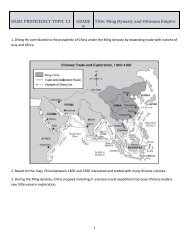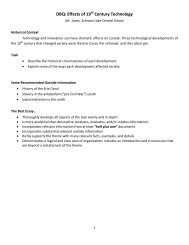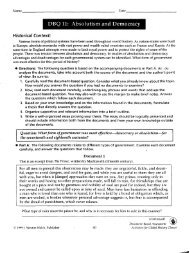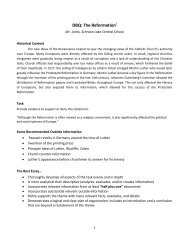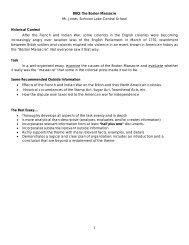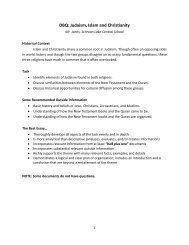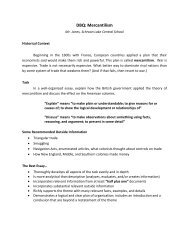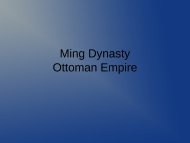3. Zhou Dynasty.pdf
3. Zhou Dynasty.pdf
3. Zhou Dynasty.pdf
You also want an ePaper? Increase the reach of your titles
YUMPU automatically turns print PDFs into web optimized ePapers that Google loves.
Rise<br />
Great Leader<br />
Achievements<br />
Fall
Before the <strong>Zhou</strong> was the<br />
Shang<br />
<br />
1750-1045 BCE<br />
Aristocracy<br />
warlords<br />
Anyang<br />
Oracle bones<br />
Human sacrifice<br />
Ancestor worship<br />
bronze
“The Enduring <strong>Zhou</strong>”<br />
<br />
Early <strong>Zhou</strong> (Western <strong>Zhou</strong>) Period 1122 - 771 BCE<br />
Spring and Autumn period (Eastern <strong>Zhou</strong>)) 771 - 481<br />
BCE<br />
Warring States era (during the Late <strong>Zhou</strong>), 481 - 221<br />
BCE
I. Rise of the <strong>Zhou</strong>
Pattern: The Rise<br />
<br />
1. Great Leader leads a rebellion or a conquest of<br />
smaller, independent, neighboring political units.<br />
2. Empires grow around trade centers or trade<br />
networks.<br />
<strong>3.</strong> The shape of empire is determined by geography.
Rise of the <strong>Zhou</strong><br />
<br />
1050 BCE King Wen of the<br />
<strong>Zhou</strong> plans rebellion against<br />
Shang <strong>Dynasty</strong><br />
1045 BCE King Wu (son of<br />
King Wen) leads military<br />
coalition<br />
Actually Uncle Duke of<br />
<strong>Zhou</strong> is in charge… Wen<br />
just a boy<br />
“blood thick enough in the<br />
capital to float blocks of<br />
wood”<br />
King Wu of <strong>Zhou</strong> = first<br />
King of <strong>Zhou</strong>, “Ji” family
Rise of the <strong>Zhou</strong><br />
Trade networks --<br />
Made roads and canals<br />
for trade reasons
Geography and the<br />
<strong>Zhou</strong>
II. Great Leader of the<br />
<strong>Zhou</strong>
Pattern: Great Leader<br />
<br />
1. Great Leader who founds an empire borrows from<br />
the past and uses religion to support his legitimacy<br />
2. Great Leader skillfully exercises potestas and<br />
autoritas (potestas = brute force power; autoritas =<br />
authority from respect)<br />
<strong>3.</strong> Succession is within Great Leader’s family, though<br />
not all offspring are great.<br />
4. Great Leader assembles a written law code
Mandate of Heaven<br />
The take over of the<br />
<strong>Zhou</strong> from the Shang<br />
was credited with<br />
the doctrine forming<br />
a Mandate of<br />
Heaven, which<br />
provided that the<br />
emperor or king<br />
ruled by divine right.<br />
If the rulers were<br />
overthrown, the<br />
Mandate of Heaven<br />
was transferred to<br />
the victors.
Pattern 4. Law Code<br />
<br />
oldest document on law<br />
= “Kang Gao”<br />
instructions issued by<br />
King Wu of <strong>Zhou</strong> to a<br />
younger prince<br />
How to govern a fief
III. Apex of the <strong>Zhou</strong>
1.<br />
2.<br />
Pattern: Achievements<br />
There is a period of peace and prosperity at the height of an<br />
empire (“Pax”). <br />
Empires connect their districts with protected<br />
road/communication networks.<br />
<strong>3.</strong> Empires develop bureaucracy to manage the empire and divide it<br />
into administrative districts such as provinces or satrapies.<br />
4. Cultural diffusion occurs through trade.<br />
5. Empires enjoy accomplishments in the arts, literature, sciences,<br />
philosophy, and architecture during their height.<br />
6. The language of the dominant culture or trading people becomes a<br />
“lingua franca” for the region.<br />
7. There is a social hierarchy with limited social mobility
Pattern 1. “Pax” of the<br />
Permanent capital<br />
(instead of moving) –<br />
Xian on Wei river<br />
Lasts until 8 th century<br />
BCE when<br />
fragmentation begins<br />
<strong>Zhou</strong>
Pattern 2. protected<br />
Road/Communication<br />
Extremely limited – lack<br />
Networks<br />
of good infrastructure helped weaken king’s power…
Pattern <strong>3.</strong> Bureaucracy<br />
Corvee labor<br />
Mandatory work for the <br />
state for certain period<br />
Bureaucracy – strong<br />
centralized state, esp.<br />
eastern <strong>Zhou</strong> period<br />
Beginnings of<br />
government jobs due to<br />
talent instead of “who<br />
you knew” (meritocracy)<br />
Rise of the Shi
The Shi [“shr”]
Limited contact with other cultures<br />
However…<br />
Pattern 4. Cultural<br />
<strong>Zhou</strong> people lived originally on western edge of<br />
Shang realm<br />
Adopted agriculture from the Shang<br />
Other cultural features?<br />
Diffusion<br />
In this case, the cultural diffusion is within Chinese<br />
culture zone
use of iron<br />
Pattern 5.<br />
Accomplishments<br />
<br />
perfection of the calendar<br />
regular astronomical observation & recording of astronomical<br />
events<br />
1 st geographical maps<br />
division of China into the Nine Provinces<br />
discovery of magnetism<br />
acupuncture<br />
Masters of bronze, horse drawn chariots, crossbow<br />
Source: http://www.chinaknowledge.de/History/<strong>Zhou</strong>/zhou-tech.html
Confucianism<br />
<br />
Starts during <strong>Zhou</strong> dynasty<br />
To be explained in the Han <strong>Dynasty</strong> in Topic 4 of this<br />
course…
Square-Field or Well<br />
Field System<br />
井 (jǐng), = “well”<br />
Square of land divided = nine <br />
identically-sized sections<br />
8 outer sections -- serfs<br />
Produce all theirs<br />
center – communally<br />
cultivated for landowner<br />
(aristocrat)<br />
By the 8 families<br />
All produce to owner<br />
Owner send portion to King<br />
all fields were aristocratowned
Source:<br />
Big-time Agriculture<br />
Fertilization<br />
Animal-drawn plows<br />
and farm tools<br />
huge agricultural<br />
expansion<br />
Hunting becomes just a<br />
sport<br />
Huge populations in<br />
some cities
directed by the government<br />
government - store surplus<br />
food & distribute it in times<br />
of famine or bad harvest<br />
Rice introduced this era<br />
Irrigation<br />
Reservoirs<br />
Dams & sluices<br />
large irrigation canal<br />
system<br />
Agriculture
Pattern 6. Lingua Franca<br />
Chinese character for “listening”<br />
<br />
written script evolved<br />
into its modern form
Pattern 7. Social<br />
Hierarchy<br />
Leaders appoint people to<br />
oversee each of the<br />
territories<br />
started off as walled off<br />
cities.<br />
leader of each of territories<br />
= lords<br />
receiving the title through<br />
inheritance.<br />
fighting men<br />
peasants<br />
slaves.
The Enduring <strong>Zhou</strong><br />
System: nobles own<br />
land, peasants work it<br />
“Son of Heaven”<br />
Feudalism
IV. Fall of the <strong>Zhou</strong>
Patterns: The Fall<br />
<br />
1. Leadership crisis: Government becomes corrupt. Leader may<br />
be distant, incompetent, insulated by attendants or<br />
uninterested.<br />
2. There are foreign threats. This may take the form of mass<br />
immigration or military threat.<br />
<strong>3.</strong> Economic collapse – inflation, depression, money<br />
devaluation, disruption of vital trade routes.<br />
4. Through time, wealth becomes consolidated. The gap<br />
between rich and poor widens. The tax burden is shifted to<br />
the lower classes. Tension between classes increases.<br />
5. Empire breaks up into smaller political units
Pattern 1. Leadership<br />
royal line broken 8 th cen.<br />
BCE<br />
power of the <strong>Zhou</strong> court<br />
gradually diminished<br />
King <strong>Zhou</strong> Pingwang’s<br />
(770 BCE) reign onwards,<br />
the <strong>Zhou</strong> kings ruled in<br />
name only<br />
true power lying in the<br />
hands of regional nobles<br />
declaring themselves to<br />
be independent kings<br />
Crisis
Qin people<br />
Pattern 2. Foreign<br />
Migrate into region<br />
from where <strong>Zhou</strong><br />
originate<br />
Warfare within China<br />
becomes “endemic” as<br />
warlords fight to<br />
consolidate power<br />
Threats
Pattern <strong>3.</strong> Economic<br />
Local aristocrats cease<br />
making tax payments<br />
up the chain to the king<br />
King no longer<br />
powerful enough to<br />
enforce<br />
Collapse
Pattern 4. Gap between<br />
Large populations<br />
result from improved<br />
farming<br />
Land = wealth<br />
In hands of aristocracy<br />
Rich and Poor
Pattern 5. Breakup<br />
<br />
fragmentation of the kingdom<br />
Esp. Spring and Autumn period<br />
Brief reunification 5 th century BCE<br />
dynasty ended in 256 BCE when the last king of<br />
<strong>Zhou</strong> died<br />
King Nan of <strong>Zhou</strong><br />
none of his sons bothered to claim title of King of<br />
China
nobles did not even<br />
bother to symbolically<br />
acknowledge loyalty to<br />
the Ji family<br />
Qin Shi Huang's<br />
unification of China<br />
concluded in 221 BC<br />
with the establishment<br />
of the.<br />
Qin <strong>Dynasty</strong>
Cycle starts again…<br />
Qin Shihuangdi<br />
Great Wall<br />
Legalism<br />
Only 14 years…<br />
Qin



